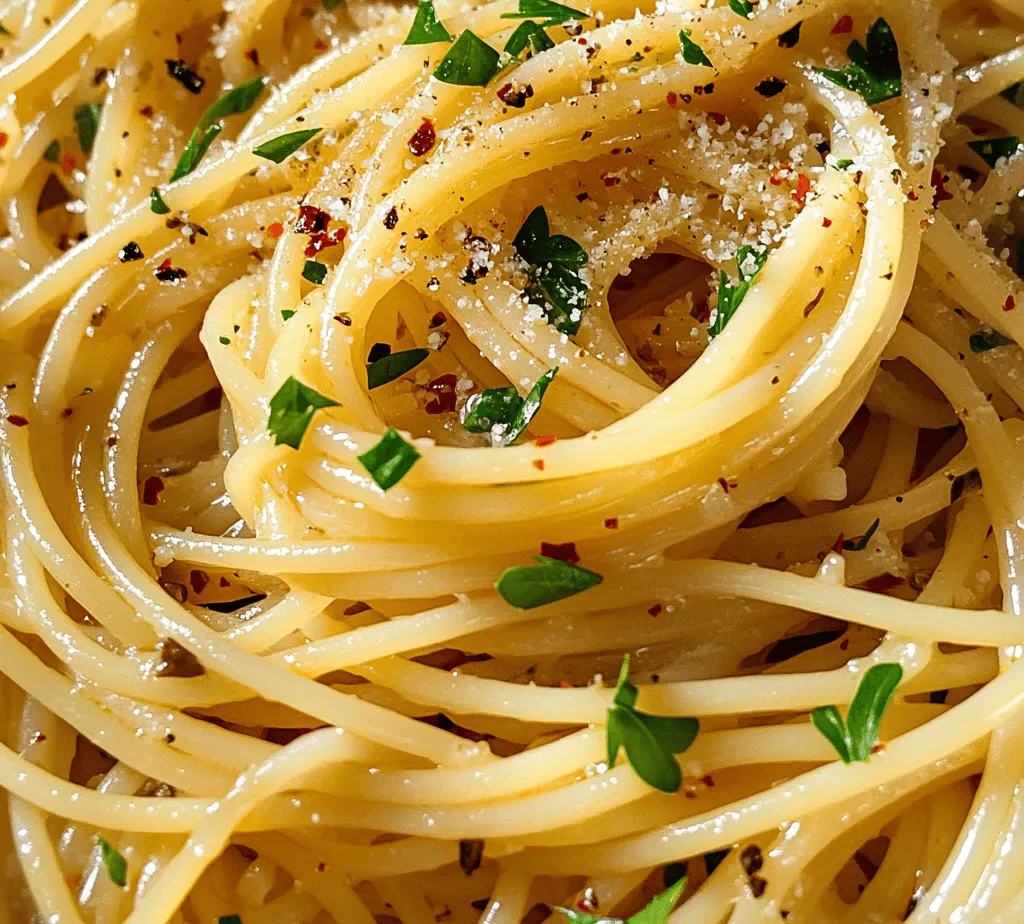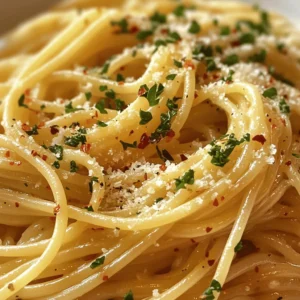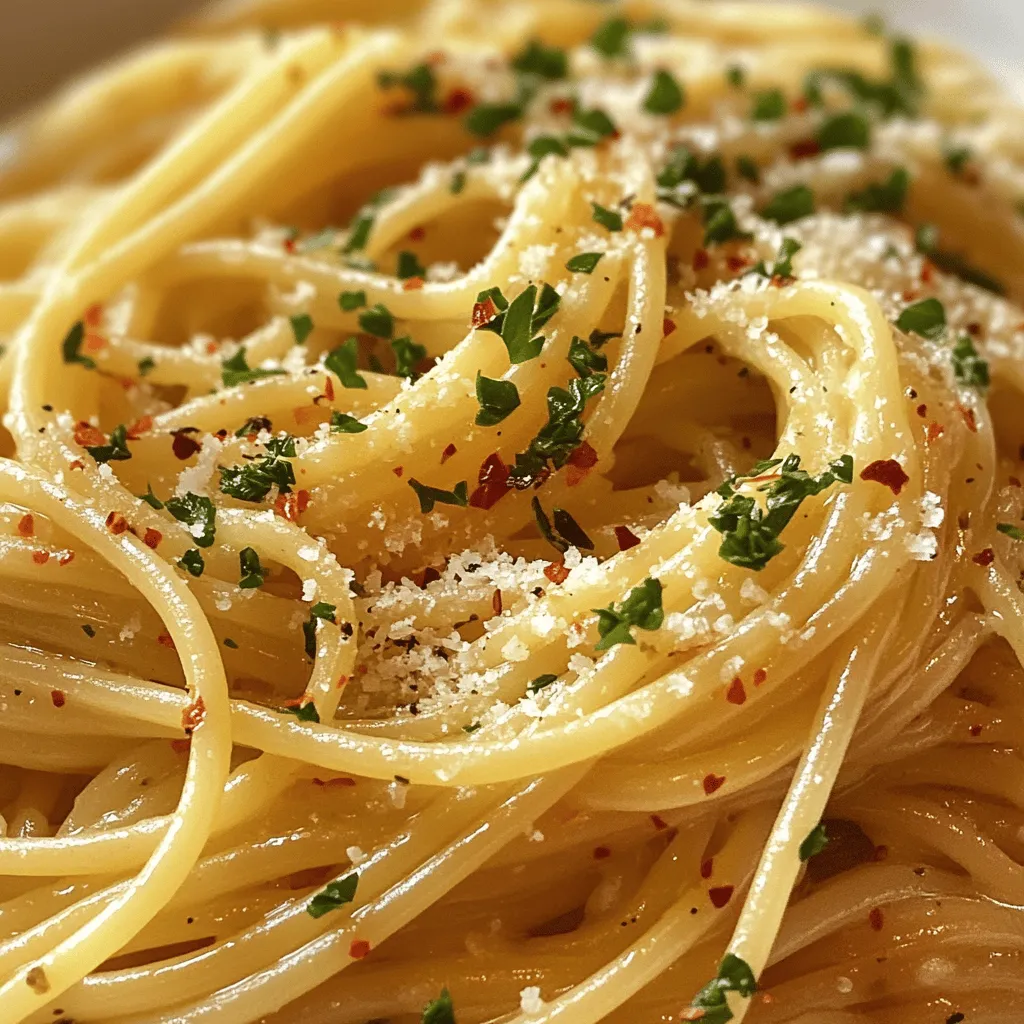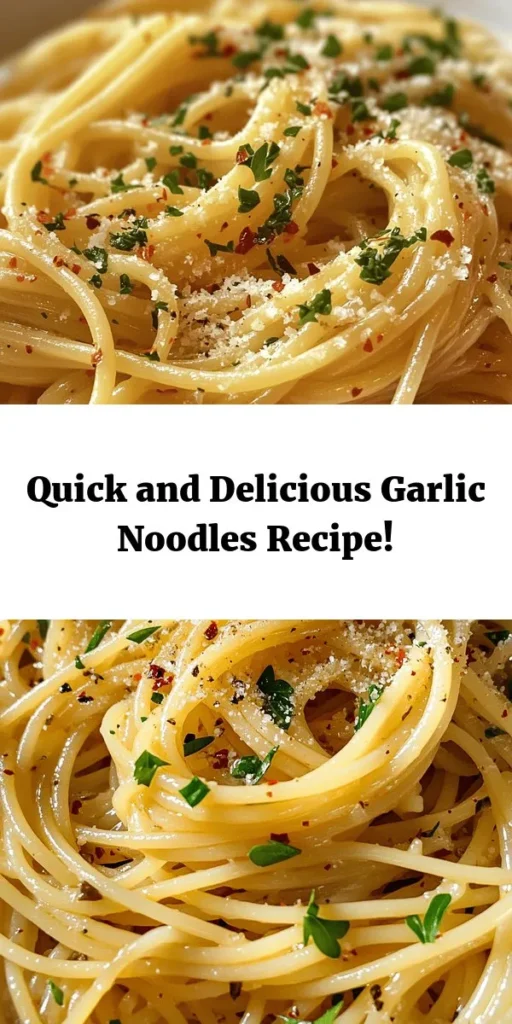Introduction
Garlic noodles have garnered a special place in the hearts of food lovers everywhere, acting as a comforting, flavorful dish that can effortlessly elevate any meal. Whether you’re looking for a quick weeknight dinner or an impressive side dish to complement a larger feast, garlic noodles fit the bill perfectly. Their alluring aroma and rich flavor come together in a dish that is not only delicious but also remarkably easy to prepare. With just a handful of ingredients and minimal cooking time, you can whip up a plate of garlic noodles that will leave everyone asking for seconds.
This recipe for garlic noodles stands out for its simplicity and speed, making it a staple in many households. Busy weeknights can be hectic, but with this recipe, you can have a satisfying meal on the table in under 30 minutes. Not only are they quick to make, but garlic noodles also shine on the dinner table, making them an impressive option for entertaining guests. Let’s dive into the world of garlic noodles and explore their origins, cultural significance, and how to make them perfectly.
Understanding Garlic Noodles
Garlic noodles, as the name suggests, are pasta dishes that are prominently flavored with garlic. This dish has its roots deeply embedded in Asian cuisine, particularly influenced by Vietnamese and Chinese culinary traditions. In Vietnam, garlic noodles are often served as a side with grilled meats, showcasing how versatile these noodles can be. The dish has transcended its origins and now appears in various forms across many cultures, each adding its unique twist to the basic garlic noodle concept.
One of the reasons garlic noodles have become so popular is their incredible adaptability. You’ll find variations that include different proteins, vegetables, and sauces, allowing for a customized experience. From the classic garlic butter preparation to more complex renditions featuring seafood or vegetables, garlic noodles cater to a wide range of taste preferences. Their universal appeal lies in the harmonious blend of flavors, making it a beloved dish around the globe.
Ingredients Breakdown
Creating the best garlic noodles requires a careful selection of ingredients, each playing a crucial role in achieving the ultimate flavor profile. Here’s a breakdown of the key components that make this dish so delightful:
Spaghetti or Linguine
The choice of pasta is essential for texture and presentation. While traditional garlic noodles can be made with various types of noodles, spaghetti or linguine are the most common choices. Spaghetti offers a classic twist, while linguine’s flat shape allows for an even coating of the garlic butter sauce. Opt for high-quality pasta to ensure that it holds up well when tossed with the flavorful sauce.
Unsalted Butter
Unsalted butter is the backbone of this dish, contributing to its richness and flavor. Using unsalted butter gives you control over the saltiness of the final dish, allowing you to season it to your preference. The butter melts beautifully, creating a luscious sauce that envelops each strand of pasta, enhancing every bite.
Garlic
Garlic is undoubtedly the star ingredient in this recipe. Not only does it add a robust flavor, but it also offers numerous health benefits, including antibacterial properties and potential cardiovascular advantages. Fresh garlic is recommended for the best flavor; however, if you are in a pinch, pre-minced garlic can suffice. The key is to sauté the garlic gently to avoid burning, which can impart a bitter taste to the dish.
Soy Sauce and Oyster Sauce
For umami depth, both soy sauce and oyster sauce are essential. Soy sauce brings a salty, savory note, while oyster sauce adds a hint of sweetness and complexity. Together, they create a well-rounded flavor that elevates the garlic noodles from simple to extraordinary. These sauces are staples in many Asian cuisines, making them perfect for this dish.
Fish Sauce (Optional)
Fish sauce is an optional ingredient that can take your garlic noodles to the next level. It brings a unique depth of flavor that enhances the overall umami profile of the dish. While it may not be for everyone, if you enjoy the bold flavors of Southeast Asian cooking, adding a splash of fish sauce can add complexity that is truly worth trying.
Fresh Herbs
The inclusion of fresh herbs, such as green onions or cilantro, adds brightness and freshness to the dish. These herbs not only enhance the visual appeal of the garlic noodles but also provide a burst of flavor that balances the richness of the butter and sauces. Always opt for fresh herbs over dried for the best results.
Red Pepper Flakes and Black Pepper
To achieve a perfect balance of flavors, a sprinkle of red pepper flakes or a dash of black pepper can add just the right amount of heat. Adjust the quantity based on your spice tolerance to create a dish that suits your palate. The heat complements the garlic, giving the noodles an extra layer of flavor.
Grated Parmesan Cheese (Optional)
While not traditional, a sprinkle of grated Parmesan cheese can provide an additional layer of richness and flavor to garlic noodles. It is particularly popular among those who enjoy a more Italian twist on the dish. Feel free to experiment and see if this enhancement is to your liking.
Step-by-Step Cooking Instructions
Now that we have a solid understanding of the ingredients, it’s time to dive into the cooking process. Follow these detailed steps to create your own delicious garlic noodles:
Step 1: Cooking the Noodles
Begin by bringing a large pot of salted water to a rolling boil. The salt is essential, as it flavors the pasta as it cooks. Once the water is boiling, add your spaghetti or linguine. Stir occasionally to prevent the noodles from sticking together. For al dente perfection, cook the pasta according to package instructions, usually around 8-10 minutes. To ensure the best texture, taste the noodles a minute or two before the recommended cooking time; they should be tender yet firm to the bite.
Step 2: Preparing the Garlic Butter Sauce
While the noodles are cooking, it’s the ideal time to prepare the garlic butter sauce. In a large sauté pan, melt unsalted butter over medium heat. Once the butter is bubbling and foamy, add minced garlic. Sauté the garlic gently for about 1-2 minutes, stirring frequently to prevent it from browning. The goal is to infuse the butter with the garlic flavor without burning it.
Step 3: Combining the Ingredients
Once the garlic is fragrant and golden, reduce the heat to low and add the cooked noodles directly into the sauté pan. Be sure to reserve a cup of pasta cooking water before draining the noodles; this starchy water can be used to adjust the sauce’s consistency if needed. Using tongs, toss the noodles in the garlic butter, ensuring each strand is well-coated.
Step 4: Adding Flavor Enhancers
Now it’s time to incorporate the soy sauce and oyster sauce. Drizzle both sauces over the noodles, stirring to combine. If you’re using fish sauce, add it at this stage as well. If the noodles seem dry, gradually add some reserved pasta water until you achieve your desired sauce consistency. You want a glossy finish that clings to the noodles without being soupy.
Step 5: Finishing Touches
To elevate the dish, sprinkle in red pepper flakes and black pepper, adjusting the spice level to your preference. Toss in the chopped fresh herbs and mix well. If you’re opting for grated Parmesan cheese, now is the time to add it, giving the noodles a creamy texture. Toss everything together until well combined, and your garlic noodles are ready to be served.
This step-by-step guide provides a clear path to creating the best and easiest garlic noodles, ensuring that you can enjoy this delightful dish in no time. Stay tuned for the next section, where we will explore additional tips for achieving the perfect garlic noodle experience and answer some common questions you might have about this beloved dish.

Preparing the Sauce
One of the critical components of the best and easiest garlic noodles is the sauce. Garlic is the star of this dish, and how you sauté it can make all the difference. To achieve that perfect balance of flavor without burning the garlic, follow these techniques:
1. Choose the Right Pan: A wide, heavy-bottomed skillet or wok distributes heat evenly, which helps in cooking garlic gently. Avoid non-stick pans for this recipe, as they can make it difficult to achieve that golden-brown color.
2. Use Low to Medium Heat: Start by heating your oil over low to medium heat. High temperatures can cause garlic to burn quickly, resulting in a bitter taste. Patience is key here; allowing the garlic to gently cook will bring out its natural sweetness.
3. Add Garlic at the Right Time: Once your oil shimmers, add minced garlic. Stir frequently to ensure even cooking. Garlic cooks quickly, so keep an eye on it—usually, 30 seconds to a minute is sufficient for it to turn fragrant and lightly golden.
4. Deglaze the Pan: If you notice any bits sticking to the pan, add a splash of your broth or water before the garlic burns. This will lift those flavors and integrate them into your sauce.
Mixing in Seasonings
After the garlic is sautéed to perfection, it’s time to mix in your seasonings. Balancing flavors is crucial in creating a cohesive sauce that elevates your garlic noodles.
1. Soy Sauce and Oyster Sauce: These two sauces form the base of your flavor profile. Soy sauce adds saltiness, while oyster sauce contributes a rich umami taste. Start with a tablespoon of each and adjust according to your preference.
2. Sugar for Balance: A pinch of sugar can help to balance the saltiness from the soy sauce and enhance the overall flavor. Taste your sauce as you go, adding more sugar if necessary.
3. Sesame Oil: This oil is potent and should be used sparingly. A teaspoon will add a nutty aroma and flavor that complements the garlic beautifully.
4. Black Pepper and Chili Flakes: For those who enjoy a bit of heat, a sprinkle of black pepper and chili flakes can enhance the dish. Start with a small amount and increase it to suit your taste.
Tossing the Noodles
Now that your sauce is ready, it’s time to toss in the noodles. This step is crucial for ensuring that every strand is coated in deliciousness.
1. Cook Noodles Al Dente: Make sure your noodles are cooked al dente according to package instructions. This texture helps them hold up when tossed with the sauce.
2. Reserve Pasta Water: Before draining your noodles, reserve a cup of pasta water. This starchy water can be added to your sauce if you need to loosen it up.
3. Combine with the Sauce: Add the drained noodles to your skillet with the sauce. Use tongs or a pasta fork to gently toss the noodles until they are evenly coated. If the sauce seems too thick, add a little reserved pasta water to achieve the desired consistency.
4. Final Tossing Technique: When tossing, lift the noodles from the bottom of the skillet and rotate them. This technique ensures that all noodles get the same amount of sauce and flavor.
Adding Freshness
The finishing touches are what truly elevate garlic noodles from good to great. Fresh herbs and spices can bring an explosion of flavor that complements the richness of the dish.
1. Fresh Parsley: Chopped fresh parsley is a classic garnish for garlic noodles. It adds a pop of color and freshness. Stir in a handful right before serving to wake up the dish.
2. Green Onions: Sliced green onions can also add a nice crunch and a mild onion flavor. Sprinkle them on top as a garnish.
3. Lime Juice: A squeeze of lime juice can brighten the overall taste of the dish. It adds a zesty contrast to the richness of the garlic and butter.
4. Other Herbs: Feel free to experiment with other herbs such as basil or cilantro. Each herb will impart a unique flavor profile, enhancing the dish in different ways.
Customization Options
One of the great things about garlic noodles is their versatility. You can easily customize the dish according to your dietary preferences or what you have on hand.
Ingredient Substitutions
1. Gluten-Free Options: If you’re looking for gluten-free alternatives, consider using rice noodles or gluten-free spaghetti. Both options will work well with the sauce and maintain a satisfying texture.
2. Vegan Alternatives: For those following a vegan diet, substitute butter with olive oil or vegan butter. Nutritional yeast can be added to provide a cheesy flavor without the dairy.
3. Protein Additions: Garlic noodles can be turned into a complete meal by adding protein. Grilled chicken, sautéed shrimp, or tofu are excellent additions. Cook the protein separately and mix it in during the final toss.
4. Vegetable Add-ins: Feel free to toss in some vegetables for added nutrition. Stir-fried bell peppers, snap peas, or broccoli can complement the noodles beautifully.
5. Adjusting Spice Levels: If you prefer a milder dish, reduce the amount of chili flakes. For spice lovers, consider adding sriracha or a dash of hot sauce for an extra kick.
Nutritional Information
Garlic noodles not only deliver on flavor but also come with numerous nutritional benefits.
1. Caloric Breakdown: A typical serving of garlic noodles (without added protein) contains approximately 350-400 calories, depending on the amount of oil and butter used.
2. Fats and Carbohydrates: The dish has about 15-20 grams of fat, primarily from the butter and oil, and roughly 50-60 grams of carbohydrates from the noodles.
3. Health Benefits of Garlic and Parsley: Garlic is known for its health benefits, including boosting the immune system and having anti-inflammatory properties. Parsley adds vitamins A, C, and K, enhancing the nutritional profile of the dish.
Serving Suggestions
Garlic noodles can be a versatile side or main dish, and how you serve them can elevate your meal experience.
1. Pairing Ideas: Serve garlic noodles alongside grilled meats, such as chicken or steak, or as a base for stir-fried vegetables and proteins. They also work wonderfully with seafood dishes.
2. Presentation Tips: For an appealing presentation, twirl the noodles using a fork and place them in the center of the plate. Garnish with fresh herbs and a sprinkle of sesame seeds for added texture.
3. Storing Leftovers: If you have leftovers, store them in an airtight container in the fridge for up to three days. To reheat, simply warm them in a pan over low heat, adding a splash of water or broth to prevent drying out.
Conclusion
Garlic noodles are not only incredibly easy to prepare but also offer a delightful blend of flavors that can be tailored to any palate. With their versatility and adaptability, this dish can serve as a quick weeknight dinner or a fancy side for a dinner party. The beauty of garlic noodles lies in their simplicity and the ability to experiment with ingredients and flavors.
So, gather your ingredients and give this recipe a try at home. Embrace the art of garlic noodles, and don’t hesitate to get creative with your variations. Whether you stick to the classic recipe or add your unique twist, you’re sure to impress your family and friends with this delightful dish.



